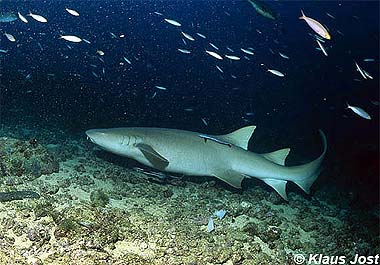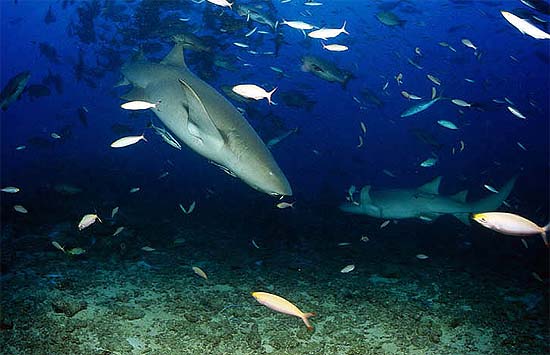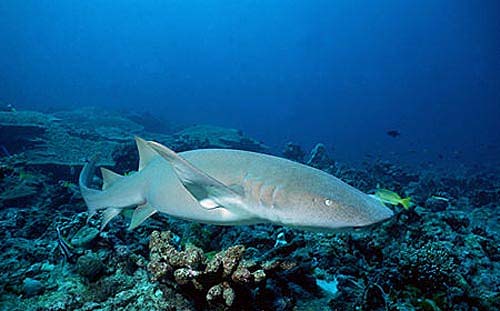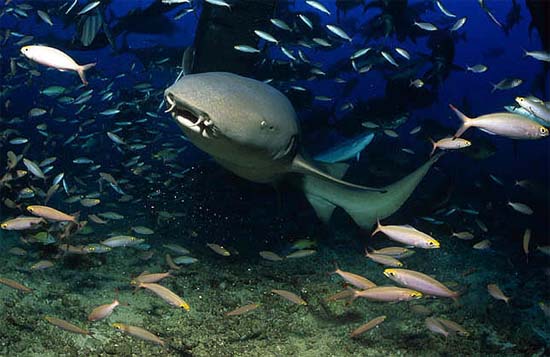Tawny Nurse Shark

Nebrius ferrugineus
This large (up to 10 feet long) and bulky carpet shark tends to be gray-brown but can modify its color based on background. It sleeps in a favorite crevice or cave during the day, often piled up with other sharks, and hunts the sea floor during the night. It hunts for small fish and crustaceans, using suction to draw its sleeping prey out of holes and cracks. This shark is docile and resilient, making it a popular aquarium feature, but because of its size and fighting spirit, it is also a target for sport fishing.
Order – Orectolobiformes
Family – Ginglymostomatidae
Genus – Nebrius
Species – ferrugineus
Common Names
English language common names are tawny nurse shark, giant sleepy shark, madame x, nurse shark, rusty catshark, rusty shark, sleepy shark, spitting shark, and tawny shark. Other common names include aarau (Kumak), bagea (ro)rodo (Gela), bákoa (Kirabati), brun nursehaj (Danish), chlarm (Khmer), cucut buta (Malay), endormi (French), gata nodriza atezada (Spanish), geelbruine verpleegsterhaai (Dutch), hiu bisu (Jawa), hiu gedebong (Bali), hiu gedok (Bali), ma’o rohoi (Tahitian), moemoeao (Samoan), moron (Malayam), nadammiyaru (Malayam), nek aarau (kumak), nidammiyaru (Mahl), paab (Carolinian), pating (Tagalong), requin dormeur (French), requin nourrice (French), Requin nourrice fauve (French), requin-dormeur fauve (French), reuse-vaakhaai (Afrikaans), rohoi (Tahitian), sunera (Marathi), and tubarão-de-leite tostado (Portuguese).
Importance to Humans

The tawny nurse shark resides in inshore waters that are heavily fished and is often captured in demersal trawls, gill nets, and baited hook and line throughout much of its range outside of Australia. In Australian waters, this species is taken in small numbers as bycatch in gillnets and meshing. Off Queensland, Australia it is fished recreationally as a big game fish and are prized as powerful fighters. The flesh is marketed as fresh or dried salted for human consumption while the fins are shipped to the Asian shark fin market. Its liver may also be utilized for vitamins and oil, the offal processed into fishmeal, and the thick hide used for leather.
Often used as an attractive display animal in aquaria, the tawny nurse shark is a tough, hardy shark that easily adapts to captivity. It is kept at public aquaria facilities throughout Europe, Japan, Singapore, and the United States.
Danger to Humans
This nurse shark is quite docile, allowing itself to be touched by divers, however there are a few non-fatal attacks on humans attributed to this species. Due to its strong jaws and sharp cutting teeth, the tawny nurse shark should be regarded as potentially dangerous and treated with respect. It is a favorite species for observation by ecotourists in waters off Thailand and the Solomon Islands.
Conservation
> Check the status of the tawny nurse shark at the IUCN website.
The IUCN is a global union of states, governmental agencies, and non-governmental organizations in a partnership that assesses the conservation status of species.
This shark’s narrow range and limited dispersion as well as low reproductive rates make it especially susceptible to the effects of overfishing. Reef habitats and local food webs have been damaged from dynamiting and poisoning in portions of its range, further increasing the tawny nurse shark’s vulnerability. There have been reports of local extinctions in waters around India and the Gulf of Thailand due to increased fisheries catch along with destruction of habitat. At this time, the tawny nurse shark is still abundant off of Australia where fishing impact is much less.
Geographical Distribution

The geographical range of the tawny nurse shark ranges includes waters off of South Africa, Mozambique, Mauritius, Seychelles, Chagos Archipelago and Madagascar to Red Sea, Maldives, Persian Gulf, India, Malaysia, Indonesia, Singapore, Thailand, Vietnam, China, Taiwan (Province of China), Japan (Ryukyu Islands, southern Honshu), Philippines (Luzon), Papua New Guinea, Australia (Western Australia, Northern Territory, and Queensland), New Caledonia, New Ireland, Samoa, Palau, Marshall Islands, and Tahiti.
Habitat
Occurring along continental and insular shelves, the tawny nurse shark resides at depths ranging from the intertidal to depths of at least 230 feet (70 m) but more commonly from 16-98 feet (5-30 m). It is observed on or near the bottom substrate in lagoons, sandy areas in close proximity to reefs, off sandy beaches, and along the outer edges of coral and rocky reefs. Although this species is primarily nocturnal, it is sometimes active during daylight hours. It often hides in caves and crevices as well as in more exposed areas, this nurse shark has even been observed piled across or on top of each other in aggregations. It has a limited home range, returning to the same area every day after foraging for prey items.
Biology

Distinctive Features
The tawny nurse shark is large and bulky. The snout is square-ish with a small mouth located well in front of the eyes that contains small comb-like teeth. The spiracles are much smaller than the eyes of this species. The pectoral fins are falcate and originate about opposite or slightly anterior to the fourth gill slits. The narrow caudal fin is short, measuring less than half the length of the body. The two spineless angular dorsal fins are located close to the caudal fin. The first dorsal fin is much larger than the second dorsal fin. The base of the first dorsal fin is located over the pelvic fin bases. There are no ridges present on the body.
This nurse shark found in the Indo-Pacific region should not be confused with the nurse shark (Ginglymostoma cirratum) of the Atlantic and eastern Pacific Oceans. Although at first glance these two species closely resemble each other, on closer inspection the tawny nurse shark can be easy distinguished by the pointed apices of its pectoral, dorsal, and anal fins as well as its narrowly falcate pectoral fins. The tawny nurse shark is also a more active swimming species than G. cirratum.
Coloration
This coloration of this shark is gray-brown or brown along the dorsal surface, depending on background habitat as this shark possesses the ability to change its coloration. This coloration fades out to a paler ventral surface. The fins are slightly dusky. Juveniles can be distinguished from adults by the presence of small dark spots on the body.
Dentition
The teeth are greatly compressed with an imbricate overlap pattern in the sides of the jaws. The functional series are separated from the replacement series of teeth by a narrow toothless space. The teeth are comb-like in shape, each with a small central cusp and three or more large cusplets on the sides. They are osteodont with the pulp cavity filled with osteodentine.
Size, Age, and Growth
The maximum reported size of the tawny nurse shark is 10.5 feet (320 cm) total length (TL). The sex of this specimen caught in Indonesian waters is unspecified. Maturity is reached by males at lengths of approximately 7.4 feet (225 cm) TL and by females around 7.6 feet (230 cm) TL.
Denticles
The lateral trunk denticles are more or less rounded-rhomboid in shape in adult specimens, with four or five incomplete weak radial ridges and a very short, blunt cusp.

Food Habits
Adults and juveniles feed on a wide diversity of benthic marine invertebrates including cephalopods, crustaceans, and sea urchins. The tawny nurse shark also feeds on small fishes including surgeonfish, queenfish and rabbitfish, as well as occasionally sea snakes. During its search for prey, this nurse shark swims along the bottom and explores holes and crevices along reefs. Upon detection of prey, it uses suction to draw out-of-reach prey items into its mouth with great force.
Reproduction
The tawny nurse shark has an aplacental viviparous (ovoviviparous) mode of reproduction. There is no embryonic nourishment from the placental structure within the mother’s uterus; the embryos feed off yolk contained within the egg case in which it grows. It appears that the tawny nurse shark practices oophagy on relatively large, cased nutritive eggs and is the first Orectoloboid known to have uterine cannibalism. However, it is unknown if the fetuses of this species eat on other fetuses (adelphophagy). In captivity, females lay cased eggs on the bottom substrate but these do not develop and may be nutritive and unfertilized. Due to the confusion caused by the appearance of free eggs, this species was at one time considered to be oviparous. This species gives birth to litters of up to 8 pups, each measuring approximately 15.8-23.6 inches (40-60 cm) in length at birth.
Predators
There are no species that regularly prey on nurse sharks. However some larger sharks are known to feed occasionally on nurse sharks found in the Atlantic Ocean. Remains of nurse sharks have been found in lemon shark and tiger shark stomachs, and attacks on nurse sharks by bull sharks and great hammerhead sharks have been observed on this closely related species.
Parasites
There are five species of tapeworms (Pedibothrium sp.) documented from the spiral intestines of the tawny nurse shark taken from the waters off Australia and French Polynesia.
Taxonomy
The tawny nurse shark was first described as Scyllium ferrugineum by Lesson (1831). However this name was later changed to the currently valid scientific name of Nebrius ferrugineus (Lesson 1831). Synonyms include Ginglymostoma concolor Rüppell 1837, Ginglymostoma ferruginea Lesson 1831, Ginglymostoma ferrugineum Lesson 1831,Ginglymostoma muelleri Günther 1870, Ginglymostoma rueppellii Bleeker 1852, Nebrius concolor Rüppell 1837, Nebrius doldi Smith 1953, Nebrius macrurus Garman 1913), Nebrodes concolor ogilbyi Whitley 1934, Nebrodes macrurus Garman 1913, and Scymnus porosus Ehrenberg 1871. The genus name Nebrius originates from the Greek “nebris, -idos”, meaning skin of a fawn. The species name, ferrugineus, is derived from Latin, referring to the brown coloration of this shark. The tawny nurse shark is a member of the family Ginglymostomtidae.
Prepared by: Cathleen Bester